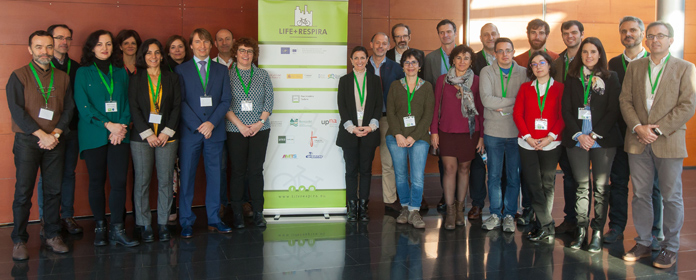Air pollution, a major problem also in medium-sized cities
According to the conclusions of project Life+Respira, carried out in Pamplona and led by the University of Navarra, pollution in these cities causes 120 hospital admissions per year.

PHOTO: Manuel Castells
Air pollution is already a relevant problem, even in medium-sized cities. According to the conclusions of project of research Life+Respira, led by the University of Navarra, in a city like Pamplona, with similar characteristics to 80% of European cities, the population is exposed relatively frequently to pollution levels higher than those recommended by the health authorities. This exhibition to pollutants is a B deterioration for the health of citizens and causes in Pamplona about 120 hospital admissions per year.
Measurements made in the study, the largest of its kind in Europe, subject, indicate that pollution varies significantly depending on the weather, the area of the city and the time of day. Although motorized traffic is the main source of pollution source , high levels of particulate matter are found in residential areas in winter, due to the use of domestic wood-burning fireplaces.
Records have also confirmed that urban vegetation can significantly reduce pollution, so that parks and gardens act as lungs that clean the city's air. However, not all trees have the same reducing effect. Specifically, in Pamplona only 9% of the trees are evergreen, which are the ones that reduce pollution the most.
The increase in pollution on the roadway is up to 40%.In addition, LIFE+RESPIRA has shown that riding on the roadway increases exhibition nitrogen oxides by 27% to 40% compared to sidewalks or bike lanes. In addition, a separation of only half a meter between the bike lane and the road greatly reduces the levels of black carbon (one of the most dangerous pollutants) to which cyclists are exposed. When this distance is not possible, the employment of vegetative separation barriers, such as hedges, financial aid to reduce the exhibition of cyclists to fine particulate matter emitted by traffic.
Another outstanding action of the project has been the elaboration of a survey of urban mobility in Pamplona, in which 473 cyclists participated. This is the largest effort made to date in the capital of Navarre to gain a better understanding of this subject of mobility. As is happening in the rest of Spain, the use of bicycles in Pamplona has increased exponentially, which is evidence of a change of habits on the part of the population towards more sustainable means of transport.
The European project LIFE+RESPIRA culminates its work after three years of development with an international seminar that hosts the School of Sciences of the University of Navarra until December 13, and brings together nearly a hundred experts and researchers in subject air quality.
LIFE+RESPIRA is a project led by the University of Navarra aimed at improving the quality of the air breathed by those who commute by bicycle in Pamplona on a daily basis. The initiative also involves the public business management Ambiental de Navarra (GAN-NIK), the Centro Nacional de Investigaciones Energéticas Medioambientales y Tecnológicas (CIEMAT) and business Pavimentos Tudela (co-financier). The LIFE financial instrument of the European Union supports all the actions that the project has developed since 2014 in Pamplona, with the idea that the experience can be replicated in other European cities.
The project LIFE+RESPIRA can be considered a clear example of citizen science where more than 200 volunteer cyclists have provided, through the use of low-cost sensors, about 15 million measurements of air quality in the city of Pamplona. Thanks to its partnership it has been possible to comprehensively characterize the distribution of urban pollutants in the city, thus complementing the data provided by the existing air quality stations, which, being located in a few fixed points, cannot collect all the pollution situations occurring in the city.
The collection of data started in May 2015. Over the next two years, volunteers made nearly 20,000 trips covering some 54,000 km in more than 15,000 hours, while the fixed and reference letter collectors operated for another 60,000 hours.
More information and graphic resources available
